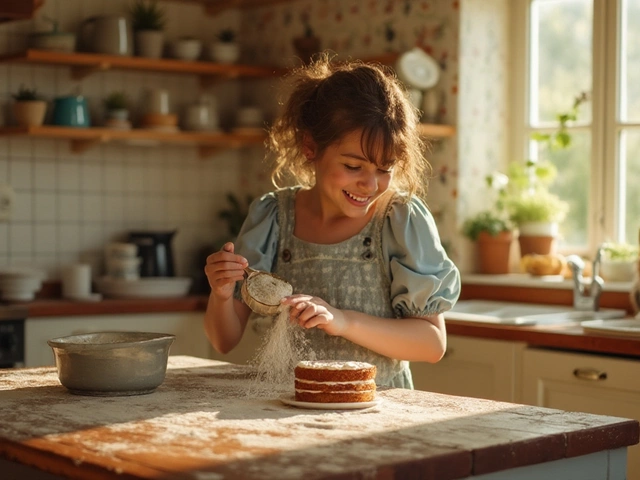Few desserts capture the essence of Italian culinary artistry like Tiramisu. This iconic treat, known for its rich layers and velvety textures, has become a beloved favorite across the globe. Its journey began in the northern regions of Italy, where it was crafted to be both an indulgence and a delightful energizer. Every bite tells a story of tradition, with roots steeped in local culture and flavor.
Embracing simple ingredients, such as coffee-soaked ladyfingers and luscious mascarpone, Tiramisu offers a perfect canvas for creativity while staying true to its origins. As we explore the depth of this dessert, we'll uncover not only the classic ways to enjoy it but also innovative twists that modern palates celebrate. Let's dive into the irresistible allure of Tiramisu and uncover why it remains a cherished centerpiece in the landscape of Italian desserts.
- Origins of Tiramisu
- Classic Ingredients and Preparation
- Cultural Significance in Italy
- Modern Variations and Tips
Origins of Tiramisu
Tiramisu, with its tantalizing layers and rich history, has become synonymous with Italian dessert culture. The origins of this beloved indulgence are as flavorful as the dessert itself. Historically, Tiramisu is traced back to the regions of Veneto and Friuli Venezia Giulia in northeastern Italy. It's believed to have originated in the late 1960s, a relatively recent creation in the grand spectrum of culinary arts. The name literally translates to "pick me up" or "cheer me up" in Italian, aptly reflecting its energizing concoction of espresso and sugar.
The story of Tiramisu's conception is a tale of legend and debate among Italians. Many attribute its creation to the restaurant Le Beccherie in Treviso, Veneto, marking it as the birthplace of the dessert. As per the lore, Tiramisu was designed by a confectioner named Roberto Linguanotto and his apprentice, Francesca Valori, whose surname was Tiramisu, thus offering double resonance to the dessert's identity. Yet, like many culinary icons, Tiramisu's precise origin remains a topic of delightful debate. A quote from the renowned gastronome, Giovanni Capnist, in his book ‘I Dolci del Veneto’ illustrates the dessert’s romance—"Tiramisu, it is a lovely sweetness fitting for every heart that needs to flutter."
An essential aspect of Tiramisu's charm is the allure of its traditional components, which were sourced locally, such as the savoiardi (ladyfingers), espresso, eggs, sugar, cocoa, and creamy mascarpone. These ingredients, while seemingly humble, are indicative of the Italian knack for transforming simple staples into gastronomical delights that whisper of both authenticity and innovation. Over the years, several towns in the Veneto region have attempted to claim Tiramisu as their own, each bringing slight variations to the foundational recipe. A point of pride for many Italians, Tiramisu not only flourished in Italy but swiftly captured hearts worldwide, riding on the back of cultural exchanges and the global expansion of Italian restaurants post-World War II.
The dessert’s path to fame did not stop at the Italian borders. By the 1980s, Tiramisu had embarked on a gastronomic journey across the globe, appearing on menus and in cookbook after cookbook. While its authenticity is often questioned when made outside its birthplace, there exists a charm in the diversity of how different cultures embrace and reimagine this iconic Italian sweet. In understanding Tiramisu's origins, one also grasitates the broader narrative of Italian culinary history, where regional specialties often evolve beyond their original locales, adapting to local tastes while still retaining their intrinsic essence. This delicate balance between maintaining tradition and welcoming innovation is what keeps Tiramisu an enduring emblem of Italian dessert mastery.
Classic Ingredients and Preparation
The Tiramisu recipe's charm lies in its straightforward yet harmonious combination of ingredients, each contributing to the dessert's distinctive flavor and texture. At the heart of Tiramisu are the delicate ladyfingers, or savoiardi, whose sponge-like consistency makes them ideal for soaking up the rich brew of espresso. This coffee infusion is not merely a feature; it is the cornerstone that brings out the dessert's invigorating character. Traditionally, the ladyfingers are briefly dipped in cooled, freshly brewed espresso, which allows them to absorb just the right amount of liquid without becoming overly soggy. It's a delicate balance that ensures the perfect moisture level required for the finished dish.
The next star of the Tiramisu is the mascarpone cheese, which lends a creamy, velvety texture that is quintessential to its luxurious feel. This Italian cream cheese is known for its high butterfat content, offering a rich, smooth consistency. It is gently combined with sugar and egg yolks to create a light custard that interplays beautifully with the coffee-soaked layers. In some traditional recipes, Marsala wine or rum is added to the mascarpone mixture, introducing a subtle warmth and complexity. This touch highlights the region's love for refined yet approachable desserts.
In Tiramisu's preparation, the layering process is crucial. Each layer begins with a foundation of coffee-soaked ladyfingers arranged neatly at the vessel's base. Over this, a generous spread of mascarpone mixture is applied with care to ensure even coverage. Repeating these layers several times, the dessert takes shape, each added piece bringing it to life. The crowning glory of a Tiramisu is an ample dusting of cocoa powder. This bold, chocolaty finish not only adorns the dessert but adds a lightly bitter counterpoint that balances the overall sweetness, sealing the layers in aromatic cocoa.
Though some might feel daunted by the idea of making Tiramisu at home, its preparation is surprisingly forgiving. Precision in measurements and the quality of ingredients are keys to achieving an authentic taste. According to culinary legend Lidia Bastianich, "Tiramisu is a dessert that invites sharing, and when well made, it can uplift any gathering." Such sentiments resonate with many who understand how this dessert is much more than the sum of its parts. It represents a love of food, community, and tradition, preserving the Italian spirit in every bite.
Cultural Significance in Italy
Tiramisu is not just a dessert in Italy; it is a heartfelt symbol of the country’s culinary magic and cultural celebration. Originating in the northeastern region of Veneto, this beloved dish is often associated with gatherings where family and friends come together around the table, sparking joy and creating memories. The communal aspect of enjoying Tiramisu is a tradition that reflects the Italian way of life, where food becomes a bridge connecting generations. Historically, its name translates to 'pick me up,' a delightful nod to its energizing qualities, something quite appreciated in a culture that values vitality and zest for life.
According to legend, the origins of this delectable dessert lie in the late 1960s or early 1970s, in a small Italian city named Treviso. Here, innkeepers claimed to have prepared Tiramisu as a mood enhancer for patrons, mixing simple yet elegant ingredients to create a dish that would lift spirits. This notion of providing comfort and joy through food is ingrained in Italian cuisine, making Tiramisu an essential part of their culinary lore. The love for Tiramisu is not just confined to historical roots; it has become emblematic in popular culture, from movies to art, symbolizing a universal appeal that transcends borders.
"In Italy, food is not just nourishment – it is the art of daily life, with Tiramisu standing out as a testament to our passion for creating joy with every bite." - A renowned Italian chef once said.Its widespread appeal means that Tiramisu is often the protagonist of many festive and family gatherings, from birthdays to weddings in Italy. Chefs and home bakers alike take pride in their unique twists to the classic recipe, which is a testament to its versatility and deep embeddedness in Italian culture. Because of its universal charm, Tiramisu also serves as an ambassador of sorts, allowing people from around the world to taste a piece of Italy's soulful heritage.
Modern Variations and Tips
As much as Tiramisu enjoys a place of honor among traditional Italian desserts, modern interpretations have sprung up, bringing new life to this classic. Chefs and home bakers alike have begun to experiment with the core elements of Tiramisu, creating delightful twists that respect the original yet offer fresh flavors. For instance, some have swapped the traditional coffee with other bold liquids like matcha tea or amaretto. This not only alters the flavor profile but also introduces Tiramisu to a wider audience who might not be coffee enthusiasts. In Italy's coastal areas, it's not uncommon to find versions infused with the zest of limoncello, giving the dessert a refreshing citrus kick while maintaining the beloved mascarpone richness.
One cannot talk about modern Tiramisu without mentioning the rise of dietary-specific variations. Gluten-free alternatives use ladyfingers crafted from rice flour or almond meal, ensuring that even those with dietary restrictions can indulge. Similarly, vegan Tiramisu substitutes mascarpone with creamy blends of tofu or cashews, combined with almond or soy milk, capturing the essence while catering to plant-based diets. The invention of these adaptations could likely be a nod to the memory of new culinary needs and preferences. Interestingly, there's a growing trend of 'deconstructed' Tiramisu, where the ingredients are presented separately or in a non-traditional arrangement, offering a playful yet sophisticated dining experience.
The beauty of Tiramisu lies in its versatility. It's not just its capacity to adjust to different palettes, but also its ease of assembly that continues to draw attention. A tip for achieving the best results is to let the tiramisu sit in the fridge for several hours, allowing the flavors to meld seamlessly. Some purists argue that a day is ideal, rewarding patience with a symphony of flavors with every taste. It's crucial to use the best quality ingredients, particularly the mascarpone and coffee, as they form the heart and soul of any Tiramisu. As famed chef Gennaro Contaldo once said,
"A great Tiramisu should be like a symphony, each ingredient playing its part to create a perfect harmony of taste."
In terms of presentation, contemporary versions of Tiramisu frequently experiment with the aesthetic. Some opt for individual servings in elegant glasses, showcasing the exquisite layers and inviting diners to experience the dessert as a personal indulgence. The use of cocoa powder can be replaced or accentuated with grated chocolate or nuts, introducing texture and deeper flavor dimensions. For those with culinary flair, artistic decorations with sauces or fresh fruit can turn the dessert into a visual masterpiece, making it not only a treat for the taste buds but also for the eyes.
Exploring these modern takes on Tiramisu offers a delightful journey through creativity and flavors. Whether sticking to the classic recipe or venturing into new territories, the key remains in the balance of ingredients and the passion poured into its preparation. Each version of Tiramisu, while distinct, ultimately pays homage to a dessert that has transcended the boundaries of time and geography, continuing to inspire and indulge those who come across it. Whether you find joy in the traditional or thrill in the new, Tiramisu's charm is that it truly offers something for everyone.




